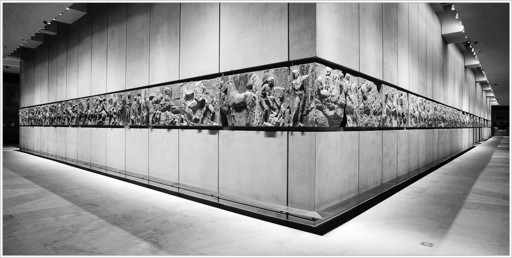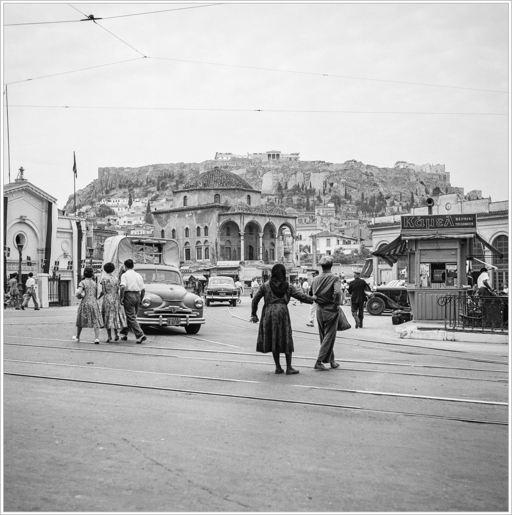The Parthenon Enigma (65 page)
Read The Parthenon Enigma Online
Authors: Joan Breton Connelly

The ingenious design and location of the museum allow one to “walk around” the Parthenon and to take in the sculptures as they were placed in antiquity, on the exterior of the temple (following page, top). What a contrast to the
Duveen Gallery at the British Museum, where the frieze is displayed outside in, as if intended for the courtyard of some latter-day Kroisos (following page, bottom). What’s more, the frieze in London is cut up into sections interrupted by doorways and voids. This arbitrary segmentation has, over the past two hundred years, profoundly affected the ways in which the frieze has been read and misread, obscuring its character as a continuous narrative. In Athens, one can stand at the east end of the hall and view the Parthenon’s east pediment, metopes, and frieze all together in one glance. The same can be done for the west end and the flanks of the temple, as one circumnavigates the gallery.
IN THE PAST DECADE
or so we have seen a deliberate shift away from the nationalist rhetoric of earlier years, at least on the part of the Greeks, who have now offered reasonable and creative suggestions for overcoming the impasse with the British Museum. In 2002, the then minister of culture,
Evangelos Venizelos, visited England with fresh ideas, declaring that “ownership” of the marbles was no longer a key issue. Proposing that the Parthenon sculptures travel back to Athens via a long-term loan agreement, Venizelos offered in exchange a never-ending rotation of the very finest antiquities that Greek museums can offer. Accommodating the British insistence on ownership, he even suggested that the gallery in which the Parthenon sculptures would be displayed be called an
“Annex of the British Museum.” His innovative and conciliatory offer was rejected out of hand.
35

Parthenon frieze as displayed in the Duveen Gallery, British Museum. (illustration credit
ill.129
)

Parthenon frieze and casts of missing slabs as displayed in the new Acropolis Museum. (illustration credit
ill.130
)
Nonetheless, the Greeks continue to employ a light touch. Language has been adjusted to call for the “reunification” rather than the “restitution” of the marbles. The International Association for the Reunification of the Parthenon Sculptures now has branches in eighteen countries. A recently adopted slogan from one organization supporting return of the marbles asks with populist simplicity, “Why not?” In May 2009, forty-five secondary school students from Kephalonia in Greece traveled to London to demonstrate in front of the British Museum. They employed a most ancient and peaceful method of protest: a circle dance.
36
There is not a world leader who fails to stop on the Acropolis for the requisite photo op when visiting Athens. Invariably including a call for the return of the Parthenon sculptures, these appearances have been taking place for years. Jackie Kennedy, wearing pearls and a dress in the brilliant blue of the Greek flag, climbed the Acropolis summit way back in June 1961 and made the appeal. The Clintons did it in 2002, as did Vladimir Putin shortly thereafter. Even Iran’s supreme leader, Ayatollah Ali Khamenei, lifted his hands to the sky as he stood before the Parthenon and called for the marbles to be returned. In October 2010, the Chinese premier, Wen Jiabao, pledged his support for the reunification of the Parthenon sculptures. Standing on the summit, he cited the historical parallel of the Summer Palace in Beijing, which was looted in 1860 under orders from Elgin’s own son, then the high commissioner to China!
37
In the meantime, we have seen in opposition to such sentiment the ideology of “cosmopolitanism” being marshaled to defend the interests of the “universal museum.”
38
The debate over the stewardship of cultural material has been reduced, by some, to a tug-of-war between the universalist cosmopolitans and the retentionist nationalists. But as Craig Calhoun thoughtfully argues in his book
Nations Matter
, and elsewhere, to regard cosmopolitanism as merely the opposite of nationalism does the former no service and, at the same time, undermines democracy and transnational institutions.
39
Cosmopolitanism’s acceptance of economistic, modernizing imaginaries ignores the value of social solidarity and collective choices in determining the nature of society. In transcending issues of identity, it advocates for “thin identities,” which come up short as underpinnings for democracy. The cosmopolitan global elite’s
insistence on a placeless universality for cultural objects further ignores the complexities of financial interests attending ownership, imbalances of power among nations, and class inequality that result in the cultural heritage of the poor remaining ever under the control of the rich.
Nevertheless, sentiments are shifting, even in England. A poll of 130,000 voters sponsored by
The Guardian
newspaper in July 2009 found that 94 percent favor return of the Elgin Marbles.
40
This might be seen as part of a larger trend that in 2004 moved Parliament to pass the Hunting Act, banning that most quintessential of elite British pastimes: foxhunting. To many, the Elgin Marbles, like foxhunting, represent an overbearing past, one not worth hanging on to in a changing world. When even the monarchy must actively court public approval to survive, no vestige of traditional Britain is sacred.
Indeed, it has been estimated that less than 9 percent of the British public has ever entered the British Museum to look at the Elgin Marbles. And even cosmopolitan foot traffic seems not to have held up. Visitorship at the new
Acropolis Museum, in only its first year, far surpassed that at the Duveen Gallery: 2 million, as against just 1.3 million who entered the British exhibition.
41
Some of this may be ascribed to the newness of the new Acropolis Museum, but if it can attract such numbers with only 40 percent of the Parthenon sculptures on display, one can just imagine the drawing power of the sculptural program made whole again.
Traditionally, official British opposition to returning the marbles has been particularly strong in the House of Lords, where the nature of peerage has made for more fantastical and unfiltered pronouncements than one might hear in the House of Commons. Urging his fellow peers to block any such surrender,
Lord Wyatt of Weeford pleaded in 1997, “My Lords, it would be dangerous to return the marbles to Athens because they were under attack by Turkish and Greek fire in the Parthenon when they were rescued and the volatile Greeks might easily start hurling bombs around again.”
42
But even the House of Lords is now changing, as hereditary peers are phased out and new life peers are made. The Wyatts of the world are being replaced by a new generation, including the archaeologist
Lord Renfrew of Kaimsthorn, a major proponent of the protection of cultural heritage.
43
Meanwhile, a new generation of politicians is also coming up. Deputy Prime Minister
Nick Clegg hosted the Marbles in Exile conference
as a resident member of the European Parliament in 2002. The Liberal Democrat MP
Andrew George now serves as chairman of the Marbles Reunited campaign.
As the national sentiment has changed, so, too, have the terms of debate, moving away from old legal arguments and toward new ones based on ethics. The actor
Stephen Fry has urged Britain to keep it classy and make a preemptive move to return the Parthenon sculptures, simply because it is the right thing to do.
44
The recent return of a fragment of the Parthenon frieze by the
University of Heidelberg is an example of an initiative that bypassed legal frameworks to put ethics first.
Maxwell Anderson, director of the
Dallas Museum of Art and former head of the Association of Art Museum Directors, has offered a compelling vision for the future in general. Facing issues of ethics, cost, and scarcity, museums should move beyond traditional roles as collectors and owners and toward ones as partners engaged in exchange.
45
Recent loans to U.S. museums from Italy, exchanges resulting from the return of antiquities illegally acquired by the J. Paul Getty Museum, the Metropolitan Museum of Art, Boston’s Museum of Fine Arts, and others, are already having an enormously positive impact. The American public is being treated to a vibrant rotation of meaningful objects that are enlivening permanent collections across the country.
Returned to the city for which they were carved, the Parthenon sculptures could take their place in what could become the world’s leading “universal museum.” For such a designation must surely be measured by how much international cooperation and interdependence an institution can foster through loans, exchanges, and other agreements. That, after all, is what globalization is meant to be good for.
Such a universalism is only fitting where the Parthenon is concerned. We are all outsiders looking in, trying to understand, striving to keep ourselves from getting in the way of what we see. A photograph taken in 1954 shows a couple in
Monastiraki Square, just north of the Athenian Acropolis (following page).
46
The woman tugs at the man’s jacket. What are we looking at? Is she pulling him back from the path of the truck speeding toward them? Or is the woman beckoning him to stop and look, to gaze up at the temple that has graced the summit of the Acropolis for nearly twenty-five hundred years? There it is, still standing, after all this time: the Parthenon. Do those who pass it every day of their lives still “see” it? Does the Parthenon stop them in their tracks
and fill them with awe? How much did the ancient Greeks themselves continue to pause and wonder, generations after the temple was built?
What we see and how we see it requires excavation through the muddy layers of
memory. Even within a single lifetime it is difficult to recall what we once saw, how we felt, and what we thought when we saw it. “I cannot paint / what then I was,” mused Wordsworth. And so we continue, with or against the current, aiming to glimpse, if only for a moment, the experience of the ancient past. Like the Athenians themselves, we are ever torn between past and present, myth and history, memory and imagination, tradition and innovation.

The Acropolis from Monastiraki Square, at the north. © Robert A. McCabe, 1954. (illustration credit
ill.131
)
Acknowledgments
If a picture is worth a thousand words, then the photographs of Socratis Mavrommatis and the drawings of Manolis Korres represent a treasure trove that could fill all the largest libraries of the world. I am deeply indebted to them for allowing their work to be shown here and thank them for generously sharing their knowledge and kindness with me during the writing of
The Parthenon Enigma
.
